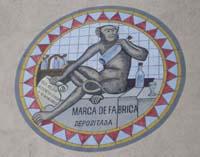Darwin, anise and buses
To say something like this was heresy at that time. They believed that man was above other species, and even more, except the atheists, the main thought was that God had in that place. And Darwin removed it and placed it among other species, more or less at the height of the monkeys.
However, the expression is not correct. Although some take literally to say, Darwin did not indicate it, but all kinds of living beings have the same origin and have evolved from one another, as if branches are formed from a tree. According to Darwin's theory, the monkey and man had a common ancestor, two branches evolved from that ancestor.

The symbol of anise The Monkey is based on Darwin and his theory. (Photo: Panoramio)
To some extent, it is not surprising that disorder or misunderstanding that some understood from the beginning. And they also used this idea to insult and despise Darwin. For example, at Oxford, the British Association for the Progress of Science, a debate was held on Darwin's book. It was attended by researchers and clergymen who gathered about a thousand listeners. One of the speakers was biologist Thomas Huxley, known as "Darwin's bulldog", and when he explained the relationship between man and monkey, the bishop of Oxford asked him what he had to prefer to his grandfather, a respectable man or a monkey.
The cartoons that were made with this subject are also well known. In one of them appears a creature with the head of Darwin and the body of a monkey. It was made by John Tenniel in 1870 and its aim was to ridicule Darwin.
But not all cartoons had the same objective. In 1872, the Catalan merchant Vicente Bosch made new labels for his anise. In those labels appeared a human monkey with a parchment in his hands, and in the parchment he put: "It's the best. Science said and I don't lie. This science was published by Charles Darwin in 1859 with his book "The Origin of Species". Yes, that anis was called El Mono and is still sold with that name and that label.
No need of God
The fact that Darwin did not need any god to explain it, provoked as much discussion as that of expressing that all species have the same origin. Precisely this was one of Darwin's greatest contributions: he proposed a mechanism to explain how species evolve, natural selection. This means that individuals who best adapt to the environment have more possibilities of reproduction than others. Thus, from generation to generation, predominate those that have the proper characteristics to develop in a certain environment, losing the others.
When Darwin presented this idea, genetics was at the beginning. But then it had a great development and the geneticists saw that there were mutations and realized that this phenomenon had a great importance in the evolution and creation of new species. As a result, the idea of natural selection was abandoned for a few years until they showed that this also influenced evolution.
In any case, when Darwin presented it they did not discard it based on scientific reasons, but because it denied God's participation. And no wonder, still today there is no more to see the bustle that has arisen in some buses with atheistic ads. What Darwin would have thought about this
Published in Gara
Buletina
Bidali zure helbide elektronikoa eta jaso asteroko buletina zure sarrera-ontzian











